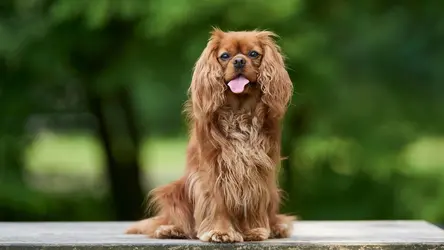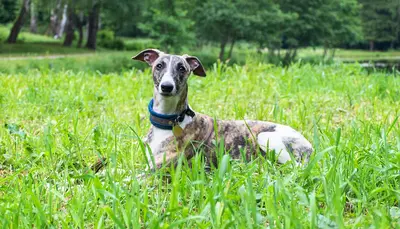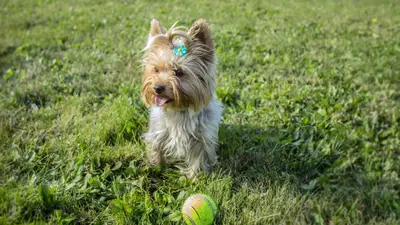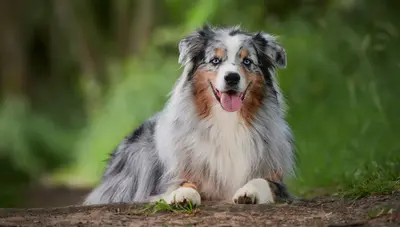Cavalier King Charles Spaniel: Breed Guide
- 23 Apr 2025
- 10m read

From royal lapdog to family favourite, the Cavalier King Charles Spaniel has been charming humans for centuries – and it's easy to see why.
Cavalier King Charles Spaniel Origin
The Cavalier King Charles Spaniel, which comes from Great Britain, is one of the most popular representatives of small breeds, bred primarily as companion dogs. Its ancestors were small, ginger and white spaniels brought to the British Isles from Malta, Italy and France.
The beginning
Small dogs of the spaniel type were known to the English aristocracy as early as the 16th century. Spaniels of that time varied in appearance and size, depending on local fashion and the preferences of a given breeder. However, they were distinguished by their delicate coat, long hanging ears, and friendly disposition.
Larger hunting dogs were used for hunting, while smaller ones kept their owners company and entertained them.
In the 17th century, pugs and Pekingese became fashionable in the British courts. This significantly influenced the appearance of miniature spaniels, which were often crossed with brachycephalic dogs. These dogs, called King Charles spaniels, were characterized by increasingly shorter muzzles and smaller sizes - they could weigh less than a kilogram.
Development of the breed
In the early 19th century, a few breeders decided to restore the miniature spaniel to its former appearance, reminiscent of that depicted in Stuart-era paintings. By crossbreeding with the old-type King Charles Spaniel, the King Charles Spaniel developed the "Cavalier" variety, which was characterized by a longer muzzle and a flatter head.
The greatest influence on the development of the breed was American Roswell Eldridge, who in the 1920s founded a prize for breeders who could present dogs resembling those in the paintings of old masters. This initiated the planned breeding of Cavaliers.
The first Cavalier club was established in 1928. The newly created variety almost completely died out during World War II. Fortunately, it was possible to recreate it based on a few surviving individuals, but this significantly impoverished the gene pool.
The official breed standard was developed in the 1930s, and in 1945 the breed was recognized by the British Kennel Club. The International Cynological Federation (FCI) officially recognized the Cavalier King Charles Spaniel in 1955.
Currently
Today, the Cavalier King Charles Spaniel is one of the most popular small breeds in the world. It is valued for its gentle nature, beauty, and devotion to humans.
The breed enjoys great recognition in countries such as Great Britain, the United States, Germany and Poland. Cavaliers are often chosen as family dogs, as well as therapy dogs, due to their calm and empathetic disposition. Despite their small size, they are full of life, joyful and fit perfectly into both apartments and houses with a garden.
What Were Cavalier King Charles Spaniels Bred For?
Cavalier King Charles Spaniels were originally bred to be companion dogs, especially for members of the British aristocracy. Their main role wasn’t hunting or guarding – it was providing comfort, warmth, and friendship.
In the days before central heating, these small spaniels would curl up on laps or even warm the feet of their owners. They were also thought to help keep fleas away from humans by attracting them to their own coats instead.
Cavalier King Charles Spaniel Breed Group
Cavaliers belong to the Toy Group – a gang of pint-sized pooches bred to be loving companions. These aren’t working dogs or hunters, but cuddle champions who excel at spreading joy and melting hearts.
Cavalier King Charles Spaniel Ideal Owner
This breed is perfect for someone who wants a loyal sidekick by their side – all day, every day. Ideal owners are gentle, affectionate, and ready to return the endless love a Cavalier gives. Whether you’re a first-time dog parent or a seasoned pooch pro, if you’ve got time for snuggles and aren’t away from home too often, a Cavalier could be your new best friend.
Cavalier King Charles Spaniel Size
Small in size but big on charm, the Cavalier King Charles Spaniel is the perfect blend of portable and cuddle-worthy.
How Big Do Cavalier King Charles Spaniels Get?
On average, an adult Cavalier will stand about 30 to 33 cm (12 to 13 inches) tall at the shoulder. Perfectly sized for laps, sofas, and travelling in style.
How Much Should a Cavalier King Charles Spaniel Weigh?
A healthy adult Cavalier typically weighs between 5.9 to 8.2 kg (13 to 18 lbs). Of course, weight can vary a bit depending on their build, activity level, and overall health – but it’s important not to let them tip the scales too far.
When Do Cavalier King Charles Spaniels Stop Growing?
Cavaliers usually reach their full size at around 12 months of age, although they might continue to fill out (especially those fluffy coats) for another few months after that.
Cavalier King Charles Spaniel Coat
Cavaliers have a double coat consisting of a long, silky topcoat and a fine undercoat , often with feathering on the ears, legs and tail. Cavaliers come in four coat colors - black and tan, ruby (a solid, deep red color), blenheim (chestnut-red patches evenly spaced on a white background) and tricolor (black and white patches with tan markings).
Do Cavalier King Charles Spaniels Shed?
Cavalier King Charles Spaniels shed small amounts of hair throughout the year. Regular brushing can help reduce shedding.
Are Cavalier King Charles Spaniels Hypoallergenic?
While they’re soft, gentle and utterly snuggle-worthy, Cavaliers aren’t considered hypoallergenic. They shed moderately and produce the proteins that can trigger allergies in sensitive humans. If you or someone in your home has allergies, it’s best to spend some time with a Cavalier first before making the leap.
How to Groom a Cavalier King Charles Spaniel
Grooming a Cavalier's coat is not complicated, but it must be systematic . The dog should be brushed every few days to remove excess dead undercoat and prevent mats from forming. Delicate poodle brushes and metal combs work best for this. During grooming, special attention should be paid to the hair on the ears, under the arms and on the tail, where the coat is most prone to matting.
Cavalier King Charles Spaniels do not require frequent bathing . Most dirt brought from a walk can be easily removed with a natural bristle brush or a damp cloth. However, if necessary, the Cavalier should be bathed using a shampoo for dogs with sensitive skin. After washing, the dog should be thoroughly dried with a towel.
The owner should also pay attention to the dog's ears and eyes, as Cavaliers tend to have recurring inflammations. The appearance of discharge under the eyes, unpleasant odor from the ears or severe itching will be an indication for a visit to the vet. The Cavalier's teeth should also be regularly brushed and their claws trimmed.
Cavalier King Charles Spaniel Personality
The Cavalier King Charles Spaniel is an energetic, cheerful and friendly dog towards people and other animals. It is quite easy to train and feels good both in a small apartment and in a house with a garden.
Are Cavalier King Charles Spaniels Good Family Dogs?
Cavaliers, like cocker spaniels , are very attached to their owners and are exceptionally affectionate towards them. They love human company and playing together. They are also gentle and patient, which is why they feel good even in families with children.
However, it must be remembered that dogs of this breed are fragile, delicate and very sensitive - therefore, children should be taught how to properly handle the animal, and contacts between the dog and children should always be supervised by an adult.
Are Cavalier King Charles Spaniels Easy to Train?
Dogs of this breed love to cooperate with their owner in exchange for attractive rewards and praise. However, blind obedience and precise execution of commands should not be expected from these dogs. In the case of problems with learning, you should not resort to using aversive methods, such as punishment or shouting - treating a Cavalier badly will only make the little one withdraw into himself and start to avoid the owner.
With good motivation, patience and understanding, a Cavalier King Charles Spaniel can be taught basic commands and various dog sports, such as hoopers (a version of agility without jumping), nosework or rally-o. However, if a Cavalier is causing problems for its owners, it is worth seeking help from an experienced behaviorist or dog trainer.
Do Cavalier King Charles Spaniels Bark a Lot?
Cavaliers are not typically noisy dogs. They may bark when something catches their attention, but are generally quite calm and even-tempered.
Are Cavalier King Charles Spaniels Intelligent?
The Cavalier is an intelligent breed that learns quickly, especially if training is based on positive reinforcement and close contact with the owner.
Can Cavalier King Charles Spaniels Be Left Alone?
Cavaliers can be destructive if left alone for too long or if bored, especially at a young age. Adequate exercise, play, and gradual familiarization with being alone will usually prevent this behavior.
Can Cavalier King Charles Spaniels Swim?
Many Cavaliers can swim and some even enjoy it, especially if introduced gently and early on. But they’re not natural-born swimmers like retrievers – their smaller size and long coat mean they can tire quickly.
Cavalier King Charles Spaniel Exercise
Cavaliers are energetic dogs that enjoy all kinds of games. However, they are not born athletes and usually do not tolerate greater physical exertion due to their rather shortened muzzle. However, they will be excellent companions for longer walks, during which they will have the opportunity to freely explore the surroundings.
How Much Exercise Does a Cavalier King Charles Spaniel Need?
Even though they’re snuggle bugs at heart, Cavaliers still need daily exercise to stay healthy and happy. Around 30–60 minutes of walking and playtime each day will do nicely. They adore a good sniffari in the park, a gentle game of fetch or simply trotting by your side.
Cavalier King Charles Spaniel Health
Like many purebreds, Cavaliers can be prone to certain health hiccups. Regular vet visits and a healthy lifestyle can make a world of difference.”
Predispositions to many diseases and congenital defects are passed on genetically in dogs. Buying a puppy from a reputable ZKwP (FCI) kennel, where the breeder examines their dogs for health, can reduce the risk of disease in the puppy.
Are Cavalier King Charles Spaniels Prone to Any Health Conditions?
Dogs of this breed are prone to various health problems, such as:
cardiac problems (mitral valve insufficiency),
syringomyelia (Arnold-Chiari malformation),
hip dysplasia ,
patella dislocation,
cataract,
retinal dysplasia,
recurrent inflammation of the ear canals,
dry eye syndrome,
eyelid shape defects (entropion and ectropion),
diabetes ,
congenital or acquired deafness,
overweight and obesity ,
hypothyroidism,
dermatological diseases,
food and contact allergies .
Cavalier King Charles Spaniel Cost
Bringing home a Cavalier King Charles Spaniel is like welcoming a tiny royal into your life – and like any regal guest, they come with a bit of a price tag.
How Much Do Cavalier King Charles Spaniels Cost?
Getting a Cavalier from a reputable breeder will usually cost between £1,500 and £3,000 depending on pedigree, health testing, and location. Ongoing costs like food, insurance, grooming, and vet care also add up – so it’s important to plan ahead.
Cavalier King Charles Spaniel Feeding
Many Cavalier King Charles Spaniels suffer from food allergies and intolerances , as well as recurring digestive problems . They are also prone to being overweight and obese if they are not given enough exercise. For this reason, it is extremely important to choose the right diet that will not cause allergies in your dog and will allow him to maintain a slim figure.
Cavalier can be fed both ready-made dry or wet food intended for miniature breeds, as well as a balanced cooked or raw diet ( BARF ). The diet of this breed of dog should consist primarily of high-quality meat and offal, but should not contain harmful ingredients, such as preservatives and artificial colors, which could cause allergies in the dog.
Many Cavalier owners decide to prepare their own food for their dog. However, creating a balanced diet is not an easy task, and any deficiencies or excesses of individual nutrients can seriously affect the dog's health.
A good alternative to home-cooked food will be meals prepared by butternut box based on recipes created by experienced experts in the field of healthy dog nutrition.




